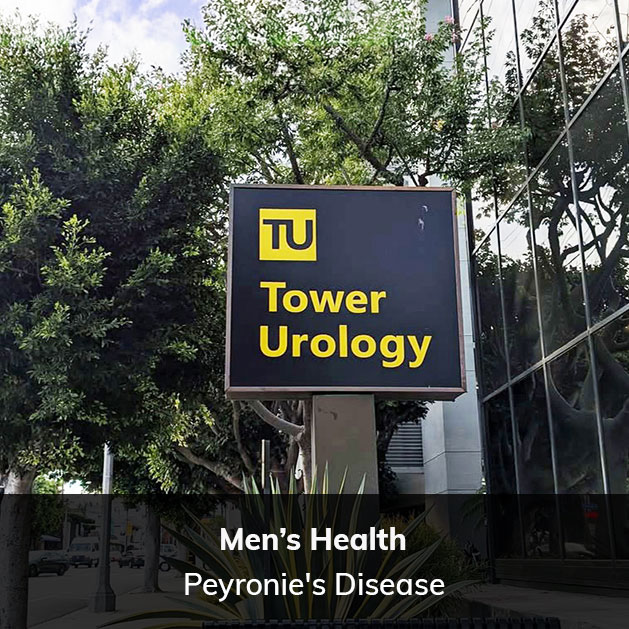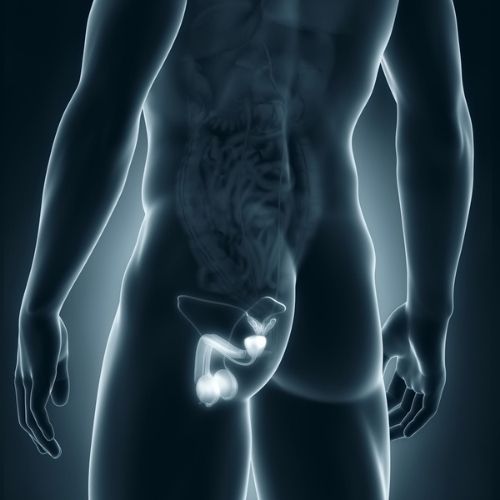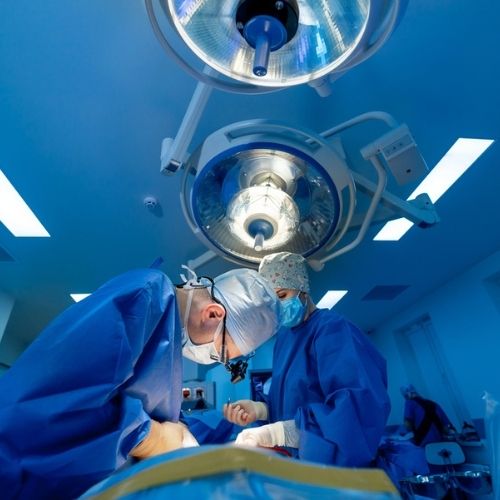What is Peyronie’s disease?
Peyronie’s disease is a condition in which fibrous plaques form in the penis, causing disfigurement, curvature, and sometimes penile shortening. Peyronie’s disease is estimated to affect about 10% of men, and it becomes more prevalent with age.
Although the common presentation of Peyronie’s disease is curvature of the penis, the plaques sometimes cause divots or indentations, which can make sexual intercourse both painful and difficult.
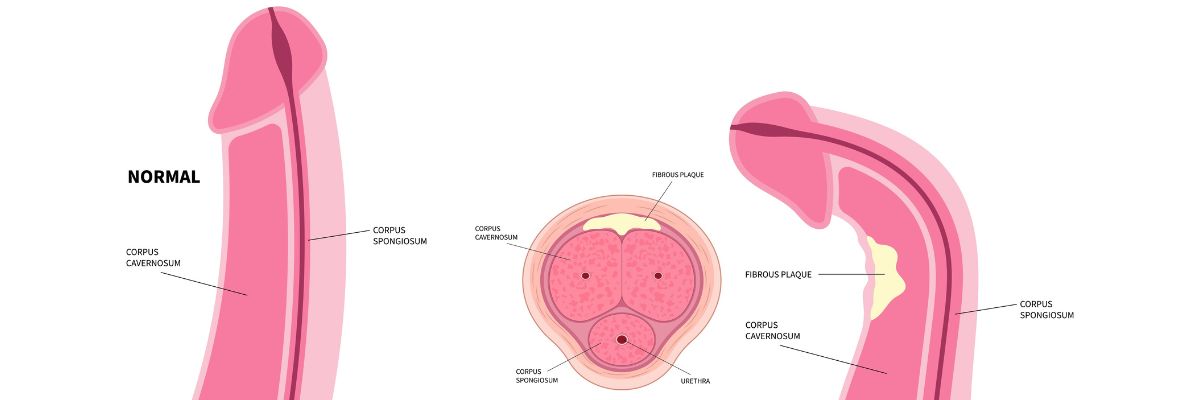
What are the signs and symptoms of Peyronie’s disease?
About 70% of the time, the disease occurs on the dorsal (top) surface of the penis. A normal penis has a certain degree of curve, and many people are born with a benign condition known as congenital curvature. However, the plaques, scars, or scar tissue associated with Peyronie’s disease may form within the tunica albuginea (capsule of the penis), which in turn cause the tissue to contract abnormally, resulting in noticeable bending, curvature, and sometimes shortening of the penis.
The following might indicate Peyronie’s disease:
- A noticeable bend or curve in the side of the penis, often obvious with an erect penis.
- Painful erections or pain during sexual activity.
- Palpable lumps or plaque under the skin of the penis.
- Shortening or narrowing of the penis.
- Difficulty with sexual intercourse.
It is important to note that Peyronie’s disease is not just a physical issue, as it can also have psychological effects. While most men will continue to be able to have sexual relations, it is not uncommon for men to experience depression and anxiety associated with Peyronie’s disease. It can be so severe that some withdraw from their sexual partners altogether.
What causes Peyronie’s disease?
Peyronie’s disease is not sexually transmitted, nor is it an infection.
The exact cause of Peyronie’s disease isn’t always clear, but common causes and risk factors include:
- Trauma or injury: Microtrauma to the penis during sexual activity or other physical impact.
- Genetic factors: A family history of Peyronie’s disease or related conditions, such as Dupuytren’s contracture.
- Age: The condition becomes more prevalent with age due to a reduction in tissue elasticity.
- Chronic conditions: Diabetes, hypertension, low testosterone (hypogonadism), and erectile dysfunction can increase the risk.
- Other health conditions: Ledderhose disease (plantar fascial contracture), tympanosclerosis, and other connective tissue disorders are associated with an increased risk of Peyronie’s disease.
Other environmental and genetic components associated with an increased risk of Peyronie’s disease include:
- Smoking.
- Excessive alcohol consumption.
- European heritage.
How common is Peyronie’s disease?
Peyronie’s disease affects approximately 10% of men (but that increases to upward of 20% of men with diabetes). However, the true prevalence of Peyronie’s is likely underreported because men are often too embarrassed to discuss their condition with their physician or to seek out help. Peyronie’s disease can affect men of any race and age.
Who does this condition normally affect?
Peyronie’s disease can affect men of all ages, but is most commonly seen in middle-aged and older men.
How is Peyronie’s disease diagnosed?
A diagnosis is primarily based on the patient’s history and a physical exam. Typically, a patient will complain of bending, curvature, or shortening of the penis.
Occasionally, a penile Doppler ultrasound is used to assist in locating the penile plaque and documenting penile blood flow, especially when Peyronie’s is associated with erectile dysfunction. The penile Doppler ultrasound entails an injection of an erectogenic agent to induce an erection, thus allowing a more accurate measurement of the degree of curvature.
What treatments are available for Peyronie’s disease?
Some men have mild disease that may resolve on its own without treatment. Others may have some permanent curvature, but not enough to bother them or their partner, and no treatment is needed.
Non-surgical options for Peyronie’s disease
For men who have issues with curvature causing embarrassment or inability to penetrate, pain, erectile dysfunction, and/or penile shortening, the following non-surgical treatment options are available:
Oral medications
Pentoxifylline is a commonly used oral therapy that inhibits some inflammatory proteins responsible for abnormal scar formation. Current literature indicates that pentoxiphyline has approximately a 40% chance of improving the plaque after six months of therapy. It is generally well tolerated with few side effects.
Although many studies have investigated various oral supplements and medications, such as vitamin E, Potaba (potassium amino-benzoate), tamoxifen, colchicine, and carnitine, none have demonstrated significant benefits in randomized controlled trials, and scientific data do not support the use of these agents.
Penile injection therapy
Similar to oral therapies, many medications and supplements have been studied for injection directly into Peyronie’s plaque, most notably verapamil and interferon. Although some studies show mild benefits from these agents, larger studies are needed to demonstrate statistical significance.
Xiaflex
Xiaflex is the only FDA-approved non-surgical treatment option approved for men suffering from Peyronie’s disease. Xiaflex is a potent collagenase enzyme that, when injected into the plaque, works by dissolving it.
Xiaflex administration consists of four cycles, with patients receiving two injections every six weeks. To achieve optimal results, Xiaflex benefits are further enhanced when combined with modeling and bending exercises performed by the patient. In clinical studies, men receiving Xiaflex reported a roughly 40% improvement in their curvature, as well as improvements in the distress they experienced due to the disease.
Although significant improvement can be seen with Xiaflex, side effects do occur, including temporary pain, bruising, and swelling. A few men in the clinical trials had a penile injury severe enough to need surgical correction. However, all of these men regained sexual function post-surgery.
Surgical treatment options for Peyronie’s disease
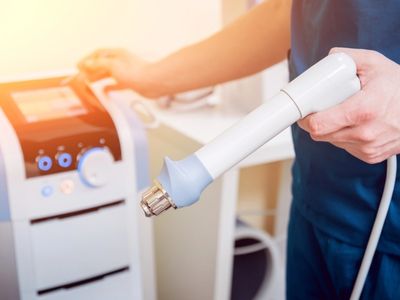
If medical or injection therapies do not result in improvement, there are several types of surgical options available. Surgical options for Peyronie’s include:
Surgical plication
This procedure is generally performed under general anesthesia. The surgeon makes an incision around the crown of the penis, pulling down the skin to expose the penile plaque. After an erection is induced using an erectogenic injection, the surgeon determines the degree of curvature and uses sutures to shorten the corporal body on the opposite side of the plaque, thus equalizing the length with the side containing the plaque.
This technique can be highly successful, but it often results in significant penile shortening, which typically leads to low satisfaction rates.
Penile plaque excision and graft
In this procedure, the skin is pulled down to expose the plaque using an incision similar to that used in plication. This surgery presents a technical challenge because plaque usually resides beneath the penile neurovascular bundle and is responsible for penile sensation.
This bundle must be elevated to fully expose the plaque without damaging the nerve fibers. This procedure involves risks, including temporary or permanent penile numbness, decreased erection strength, scarring, and shortening. Nevertheless, when performed by an experienced surgeon, it represents a potent and effective treatment option.
Penile implant
The penile implant (penile prosthesis) is an excellent choice for men with significant Peyronie’s deformity and associated erectile dysfunction. In these cases, injecting the plaque with Xiaflex or repairing it with a patch may straighten the penis. However, these methods may still leave patients unable to engage in sexual intercourse due to underlying erectile dysfunction.
An implant can correct the Peyronie’s deformity because the cylinders function as support beams to straighten the penis. Once the surgeon places the implant, they can apply pressure to the erect implant and bend the penis against its curve. With the cylinders in place, the penis has a good chance of remaining straight as the patient heals.
Shockwave therapy
At the Tower Urology’s Men’s Health Institute, we offer low-intensity shockwave therapy for treating both erectile dysfunction and pain associated with Peyronie’s disease. However, as an experimental therapy for Peyronie’s disease, studies are still ongoing to establish its role in the treatment algorithm for this condition.
What is the recovery process for different treatment options?
The recovery process varies depending on the treatment path.
- Non-surgical treatments: Minimal downtime; patients can resume normal activities immediately, with improvement seen over several weeks.
- Surgical treatments: Recovery may take several weeks; patients are typically advised to avoid sexual activity for 4-6 weeks post-surgery to allow proper healing.
Is Peyronie’s disease commonly misdiagnosed as another condition?
Yes, Peyronie’s disease can sometimes be misdiagnosed as congenital penile curvature or penile scarring from other conditions. An accurate diagnosis is crucial for determining the appropriate treatment.
Why choose Tower Urology for the treatment of Peyronie’s disease?
Peyronie’s disease can be emotionally challenging and seriously affect a man’s quality of life. But it’s important to remember that effective treatments are available. At Tower Urology, we encourage open conversations in a judgment-free environment, emphasizing that you don’t have to face this alone. With the proper care, most men experience significant improvement in both their physical and emotional well-being.
Are there treatments that Tower Urology performs that other practices generally do not?
Yes. Tower Urology offers advanced diagnostics and therapies, such as Xiaflex injection therapy and customized penile traction protocols. Our team has extensive experience in surgical treatments, ensuring optimal outcomes for even the most severe cases.
Are there treatments that other practices do that you generally don’t?
While some practices may focus solely on conservative treatments, Tower Urology offers a comprehensive range of options, from non-invasive therapies to advanced surgical interventions, ensuring that every patient receives the best care tailored to their specific condition.
Contact Tower Urology today to schedule a consultation for expert diagnosis and personalized treatment of penile curvature disease. We’ll be able to find the best solution for your needs.
Tower Urology merges decades of expertise with state-of-the-art technology and a patient-centric approach. Our team offers advanced diagnostics, specialized non-surgical treatments such as Xiaflex, and expertise in complex penile surgeries. We customize each treatment plan to the individual, ensuring the best possible outcomes.
Tower Urology is a proud affiliate of Cedars-Sinai Medical Center, ranked #1 in California and #2 in the nation by U.S. News & World Report. This partnership reflects our commitment to delivering the highest standard of urologic care with the best urologists in Los Angeles. Our years of experience, combined with access to Cedars-Sinai’s world-class facilities, and our exceptional, innovative, and state-of-the-art urological care make Tower Urology a leader in Southern California.
Tower Urology is conveniently located for patients throughout Southern California and the Los Angeles area, Beverly Hills, Santa Monica, West Los Angeles, West Hollywood, Culver City, Hollywood, Venice, Marina del Rey, and Downtown Los Angeles.
Peyronie’s disease FAQ
Urologists are the primary specialists who treat Peyronie’s disease. These medical professionals specialize in conditions affecting the urinary tract and male reproductive system, making them uniquely qualified to diagnose and manage this condition.
If left untreated, Peyronie’s disease can lead to several significant complications:
Physical Changes, Progressive Deterioration
- About 80-90% of untreated cases either remain unchanged or worsen over time, with only 10-12% showing spontaneous improvement. The condition can cause increased penile curvature, shortening of the penis, and development of painful scar tissue.
Sexual Function: Untreated Peyronie’s disease commonly leads to:
- Erectile dysfunction or inability to maintain erections
- Painful erections or pain during intercourse
- Difficulty with penetrative intercourse due to severe curvature
- Loss of penile length and girth
Psychological Impact: The condition can result in significant emotional and psychological complications, including:
- Anxiety and decreased self-esteem
- Relationship difficulties and reduced intimacy
- Lower overall quality of life
- Depression related to sexual performance concerns/
You should see a urologist as soon as you notice symptoms of Peyronie’s disease. Early treatment provides the best chance for improvement.
While both conditions involve a curved penis, there are important distinctions between Peyronie’s disease and congenital penile curvature:
Peyronie’s Disease Key Characteristics
- It develops later in life, typically in men aged 50-60
- Caused by scar tissue (plaque) formation in the penis
- Usually curves upward or to the side
- Can cause pain during erections
- May lead to penis shortening and erectile dysfunction
- Affects approximately 6-9% of men
Congenital Penile Curvature Key Characteristics
- Present from birth or noticed during teenage years
- No scar tissue involvement
- Typically curves downward or slightly sideways
- Does not cause painful erections
- Curvature remains stable over time
- Affects less than 1% of men

